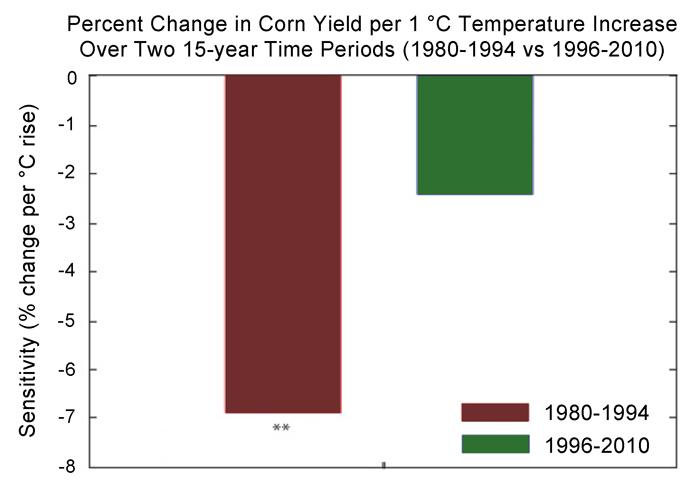| Follow @co2science |
Paper Reviewed
Leng, G. 2017. Evidence for a weakening strength of temperature-corn yield relation in the United States during 1980-2010. Science of the Total Environment 605-606: 551-558..
One of the concerns about CO2-induced global warming is that rising temperatures will stress agriculture crop growth and development and negatively impact yields. Such projected yield reductions are expected to exacerbate food insecurity issues, making it difficult to supply the dietary needs of the ever-growing population of the planet. A new study by Leng (2017), however, suggests these concerns are likely exaggerated.
Acknowledging that some studies have indeed documented a negative relationship between crop yield and temperature, Leng postulates that this relationship may not be fixed, i.e., it may weaken over time in response to genetic, agronomic and environmental changes. The rationale behind this postulation is relatively simple to comprehend. The yield/temperature relationship of crops can be "reduced through management practices such as conservation tillage (Karlen et al., 2013), soil mulching (Qin et al., 2015), multiple cropping (Seifert and Lobell, 2015), irrigation and fertilization (Stewart et al., 2005; Leng et al., 2016)." In addition, as demonstrated on our website (see Growth Response to CO2 with Other Variables (Temperature: Agricultural Crops)), rising atmospheric CO2 concentrations can help plants alleviate and even overcome the stress of rising temperatures, as can genetic modification. Thus, in an effort to test his hypothesis that crop yields may be becoming less sensitive to temperature increases, Leng conducted a statistical analysis of the strength of the relationship between the interannual variability of growing season temperature and county-level corn yields in the United States over the period 1980 to 2010.
The result is depicted in the figure below. As calculated by Leng, the sensitivity of corn yields to a 1 °C rise in temperature has attenuated with time. Over the first 15 years of the analysis (1980-1994) a 1 °C temperature increase induced a statistically significant 6.9% reduction in corn yields, whereas over the last 15 years (1996-2010) Leng calculated there was a nonsignificant 2.4% decline (see Figure 1 below). This finding, in the words of the author, "implies that projected corn yield reduction will be overestimated by [at least] a factor of 2 in a given warming scenario, if the corn-temperature relation is derived from the earlier historical period." And the significance of this fact is not wasted on Leng, who notes that "an extrapolation of historical yield response to temperature may bias the assessment of agriculture vulnerability to climate change."
Scientists and policy makers would be wise to heed such counsel, for nowhere in prior government reports has this diminishing relationship between temperature and crop yields been incorporated, which omission suggests that such reports are biased toward agricultural alarmism.

Figure 1. Percent change in corn yield per 1 °C rise in temperature over two 15-year time periods (1980-1994 and 1996-2010). Adapted from Leng (2017).
References
Karlen, D.L., Kovar, J.L., Cambardella, C.A. and Colvin, T.S. 2013. Thirty-year tillage effects on crop yield and soil fertility indicators. Soil Tillage Research 130: 24-41.
Leng, G., Zhang, X., Huang, M., Yang, Q., Rafique, R., Asrar, G.R. and Leung, L.R. 2016. Simulating county-level crop yields in the conterminous United States using the community land model: the effects of optimizing irrigation and fertilization. Journal of Advances in Modeling Earth Systems 8: 1912-1931.
Qin, W., Hu, C. and Oenema, O. 2015. Soil mulching significantly enhances yields and water and nitrogen use efficiencies of maize and wheat: a meta-analysis. Scientific Reports 5: 16210.
Seifert, C.A. and Lobell, D.B. 2015. Response of double cropping suitability to climate change in the United States. Environmental Research Letters 10: 024002.
Stewart,W., Dibb, D., Johnston, A. and Smyth, T. 2005. The contribution of commercial fertilizer nutrients to food production. Agronomy Journal 97: 1-6.
Posted 1 December 2017



